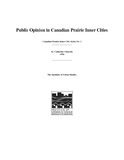| dc.contributor.author | Charette, Catherine | |
| dc.date.accessioned | 2015-08-11T19:46:38Z | |
| dc.date.available | 2015-08-11T19:46:38Z | |
| dc.date.issued | 1994-01-01 | |
| dc.identifier.isbn | 1896023126 | |
| dc.identifier.uri | http://hdl.handle.net/10680/872 | |
| dc.description | Book: xx, 145 p., digital file | en_US |
| dc.description.abstract | Since the late 1980s it has been documented that Canadian inner cities have been experiencing a reverse in a thirty year period of decline as characterized by changes in demographic, family, cultural and other socio-economic characteristics. The trend, often referred to as the back-to-the-city movement, has created a resurgence of literature on the topic. The knowledge pertaining to ongoing change and improvement in the inner city is, however, far from complete. Despite widely available theoretical discussions of such change, there are, for example, fewer "empirical observations accounting for change in the central city's built environment and its occupants and activities" (Bunting and Filion, 1988). This Series aims to make a significant contribution in terms of accurately and comprehensively defining the changing nature of the inner city-a contribution which is crucial in determining the need and form of intervention for renewal and the suitability of existing renewal
programs and public policies. With a mandate to undertake research related to urban and housing studies and to serve as a community resource, the Institute of Urban Studies (IUS) historically has led or been involved in a r:!Umber of inner-city initiatives relating largely to Winnipeg. In keeping with the current mandate of the Institute, this Series will focus upon inner-city change within the five major cities of the Canadian Prairies.
This, the first study in the Series to be published, describes public opinion in Prairie inner cities as gathered through a number of public opinion surveys, primarily the "Urban Canada Study" (Angus Reid, 1991 }. Presented are the views of inner-city residents regarding a variety of factors such as their quality of life, their satisfaction with their city as a whole, their housing, downtown and municipal services. The "Urban Canada Study" was the largest survey of the subjective views of Canadians on life in cities to be carried out since the federal Ministry of State for Urban Affairs (MSUA) commissioned York University's Institute for Behaviourial Research to carry out "A Study of Urban Concerns" in 23 Canadian CMAs in 1978. The objectives of the two surveys were similar-to assess
residents' responses to urban policy issues and to determine those aspects influencing policy preferences. Underlying these objectives, and also IUS's involvement in the "Urban Canada Study," is the rationale that subjective surveys are an important component in the making of relevant public policy. | en_US |
| dc.description.sponsorship | Canadian Mortgage and Housing Corporation | en_US |
| dc.language.iso | en | en_US |
| dc.publisher | Institute of Urban Studies | en_US |
| dc.relation.ispartofseries | Canadian Prairie Inner-City Series;1 | |
| dc.rights | info:eu-repo/semantics/openAccess | |
| dc.subject | Inner cities -- Prairie Provinces -- Public opinion | en_US |
| dc.subject | Central business districts -- Prairie Provinces -- Public opinion | en_US |
| dc.subject | Housing -- Prairie Provices -- Public opinion | en_US |
| dc.title | Public opinion in Canadian prairie inner cities | en_US |
| dc.type | Book | en_US |

